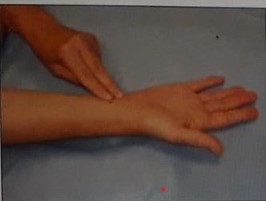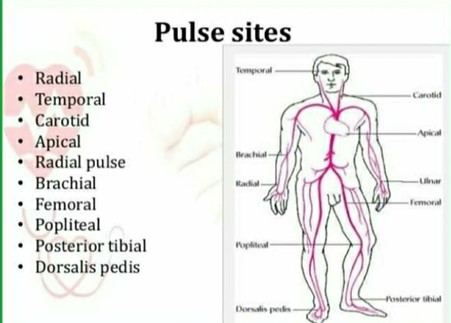The practical nurse (PN) observes a newly hired unlicensed assistive personnel (UAP) who is counting a client's radial pulse as seen in the picture. Which action should the PN take?

Instruct the UAP to report any abnormal findings.
Remind the UAP to check the client's pulse volume
Demonstrate the correct pulse site to the UAP
Confirm the accuracy of the pulse rate obtained by the UAP
The Correct Answer is C
- A radial pulse is the pulse felt at the wrist, where the radial artery runs along the thumb side of the forearm. It is one of the most common sites for measuring a person's heart rate.
- To measure a radial pulse, the examiner should place two or three fingers over the radial artery, just below the wrist crease, and apply gentle pressure until a pulsation is felt. The examiner should not use the thumb, as it has its own pulse and may interfere with the accuracy of the measurement. The examiner should count the number of beats for 15, 30, or 60 seconds, depending on the regularity and rate of the pulse.
- In the picture, the unlicensed assistive personnel (UAP) is using the thumb to measure the radial pulse, which is incorrect. The practical nurse (PN) should demonstrate the correct pulse site to the UAP and explain why using the thumb is not appropriate. This will help to ensure that the UAP obtains an accurate and reliable pulse rate for the client.
Therefore, option C is the correct answer, while options A, B, and D are incorrect.
Option A is incorrect because instructing the UAP to report any abnormal findings does not address the error in technique.
Option B is incorrect because reminding the UAP to check the pulse volume does not address the error in technique.
Option D is incorrect because confirming the accuracy of the pulse rate obtained by the UAP does not address the error in technique.

Nursing Test Bank
Naxlex Comprehensive Predictor Exams
Related Questions
Correct Answer is A
Explanation
Step 1 is to determine the amount of darbepoetin alfa in each mL of solution. The vial is labeled as “60 mcg/mL”, which means each mL contains 60 mcg of darbepoetin alfa.
Step 2 is to calculate the volume of the solution that contains 40 mcg of darbepoetin alfa. This can be done by dividing the prescribed dosage by the concentration of the solution. So, the volume is 40 mcg ÷ 60 mcg/mL = 0.67 mL.
However, since we need to round to the nearest tenth, the volume becomes 0.7 mL.
So, the correct answer is, after analysing all choices, the nurse should administer 0.7 mL of the darbepoetin alfa solution.
Correct Answer is ["A","B","D"]
Explanation
Choice A rationale:
An elevated serum creatinine level can indicate kidney dysfunction or damage, which can be a possible adverse effect of amoxicillin-clavulanate. The kidneys are responsible for excreting the medication, and elevated creatinine levels suggest impaired renal function.
Choice B rationale:
An elevated serum alanine aminotransferase (ALT) level is indicative of liver dysfunction or damage. Amoxicillin-clavulanate can sometimes cause hepatotoxicity as a side effect, and elevated ALT levels may suggest this adverse effect.
Choice D rationale:
An elevated white blood cell count (leukocytosis) can be a possible adverse effect of amoxicillin-clavulanate, indicating an increase in the body's immune response. This could be due to an allergic reaction or other adverse reactions to the medication.
Choice C rationale:
An elevated serum potassium level is not typically associated with amoxicillin-clavulanate use. This finding is more likely related to other factors such as kidney dysfunction or certain medications like potassium-sparing diuretics.
Choice E rationale:
An elevated platelet count is not typically associated with amoxicillin-clavulanate use. This finding is more likely related to other factors, such as a bone marrow disorder or inflammation.
Whether you are a student looking to ace your exams or a practicing nurse seeking to enhance your expertise , our nursing education contents will empower you with the confidence and competence to make a difference in the lives of patients and become a respected leader in the healthcare field.
Visit Naxlex, invest in your future and unlock endless possibilities with our unparalleled nursing education contents today
Report Wrong Answer on the Current Question
Do you disagree with the answer? If yes, what is your expected answer? Explain.
Kindly be descriptive with the issue you are facing.
